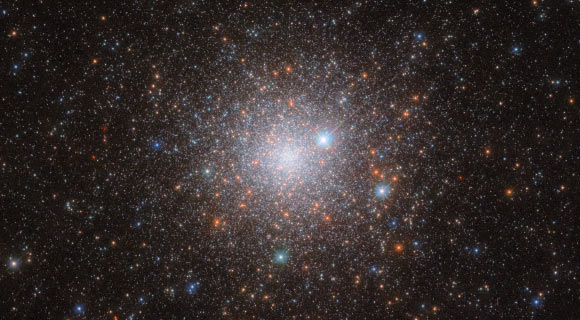A new image from the NASA/ESA Hubble Space Telescope features NGC 1786, a globular cluster located in the constellation of Dorado.
This Hubble image shows NGC 1786, a globular cluster located about 163,000 light-years away in the constellation of Dorado. The color image was made from separate exposures taken in the ultraviolet, visible and near-infrared regions of the spectrum with Hubble’s Wide Field Camera 3 (WFC3). Three filters were used to sample various wavelengths. The color results from assigning different hues to each monochromatic image associated with an individual filter. Image credit: NASA / ESA / Hubble / M. Monelli / M.H. Özsaraç.
Globular clusters are systems of very ancient stars, gravitationally bound into a single structure about 100-200 light-years across.
They contain hundreds of thousands or perhaps a million stars. The large mass in the rich stellar center of a cluster pulls the stars inward to form a ball of stars.
Globular clusters are among the oldest known objects in the Universe and are relics of the first epochs of galaxy formation. It is thought that every galaxy has a population of globular clusters.
The Large Magellanic Cloud, a neighboring dwarf galaxy about 163,000 light-years away from us, is home to approximately 60 globular clusters, including NGC 1786.
Also known as ESO 56-39, this globular cluster was discovered on December 20, 1835, by the British astronomer John Herschel.
“The data for the new image come from an observing program comparing old globular clusters in nearby dwarf galaxies — the Large Magellanic Cloud, the Small Magellanic Cloud and the Fornax dwarf spheroidal galaxy — to the globular clusters in the Milky Way Galaxy,” the Hubble astronomers said in a statement.
“Our Galaxy contains over 150 of these old, spherical collections of tightly-bound stars, which have been studied in depth — especially with Hubble images like this one, which show them in previously-unattainable detail.”
“Being very stable and long-lived, they act as galactic time capsules, preserving stars from the earliest stages of a galaxy’s formation.”
“Astronomers once thought that the stars in a globular cluster all formed together at about the same time, but study of the old globular clusters in our Galaxy has uncovered multiple populations of stars with different ages,” they added.
“In order to use globular clusters as historical markers, we must understand how they form and where these stars of varying ages come from.”
“This observing program examined old globular clusters like NGC 1786 in these external galaxies to see if they, too, contain multiple populations of stars.”
“This research can tell us more not only about how the Large Magellanic Cloud was originally formed, but the Milky Way Galaxy, too.”
